Samia Malik on Fusion Sound, Healing Songs & Activism
Samia Malik, a Saudi-born artist with Pakistani heritage, has found her artistic home in the UK since her childhood.
Her creative expression knows no bounds as she crafts captivating, bilingual songs that fuse Urdu and English, drawing inspiration from the rich tradition of Urdu ghazal.
Through her music, she fearlessly delves into pressing contemporary topics surrounding identity, race, and gender.
Her work has taken her far and wide, sharing stages with luminaries such as Baluji Shrivastav OBE, Dr Mallika Sarabhai, Giuliano Modarelli, and many more.
Boasting four albums such as The Colour of the Heart and Azaadi: Freedom, Samia Malik has consistently captivated audiences with her soul-stirring music.
However, it is her latest endeavor, Songs to Heal and Empower, that truly pushes the boundaries of her artistry.
This groundbreaking project was born during the challenging times of the Covid-19 pandemic when Samia Malik took the initiative to construct her own home studio.
Songs to Heal and Empower defies genre categorisation, introducing a fresh and daring sound that breaks free from convention.
This remarkable work represents a culmination of extensive research and development, driven by Samia’s unwavering determination to create something truly extraordinary.
But Samia’s talents don’t end with music alone.
In addition to her artistic endeavors, Samia passionately lends her talents and voice to uplift and support marginalised communities, particularly in women refuges.
She actively collaborates with numerous organisations, using her platform to raise awareness and advocate for their rights.
With such a versatile skillset and a deep-rooted involvement in pressing matters, we spoke with Samia Malik to get the scoop on her new album, activism work, and the power of music.
How did you develop your unique fusion sound?
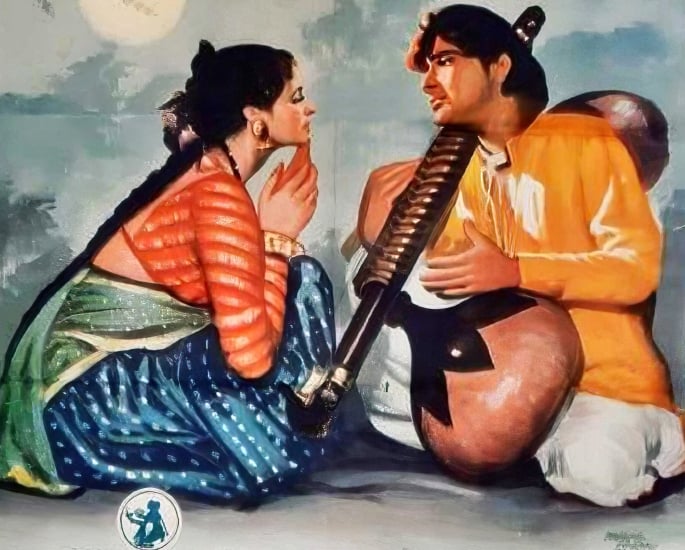

This style is who I AM – a fusion of the traditional and the contemporary, of east and west, of here but there too.
I have always been fascinated by that place where cultures meet, I suppose because that is where I live.
I grew up in a family who loved what we now term Bollywood (‘filums!’), listening to the classic Golden Oldies of the 50s/60s/70s.
From an early age, I saw Lata, Rafi, and later I discovered ghazal singers like Begum Akhter, the films of Guru Dutt, and most thrillingly, classical Indian music through the film Baiju Bawra.
But I was also growing up in the UK, in Bradford, listening to Top of the Pops and western music. It’s all in the mix!
And the issues – well, for me music has always been a way to explore my place in the world, who I am and why, and specifically to heal and empower myself.
The issues of identity, gender and race, belonging, language, healing, empowerment, etc are all things I have had to deal with DIRECTLY in my life.
In this album, I have finally broken free of the restraints of ‘Pakistani, Muslim, woman, immigrant’ etc.
All those boxes that I have had to fit into in my life, I’m finally exploring the human condition – that which is common to us all. Through music, words, and visual art.
Could you share some insights into your creative process?
Great question! I suppose for the songs and the visual art the process is similar.
I show up, regularly, get myself ready, make space, do riaz, prep my canvases, and meditate.
And for months (sometimes years I have to admit) I write words, phrases, ideas, musical riffs, everything that comes, I take it and make space to receive it.
“If I am lucky, the day or moment will come when it aligns, it forms, slowly into a new piece.”
At times, a complete song or visual idea hits me, full, ready, demanding to be caught.
But it’s usually if I have done the preparation first!
Basically, I listen. A lot. I try to move beyond my ego, the small mind. And wait. A lot. And sing. A lot. And practise. A lot!
If I am lucky, it comes. Mostly it doesn’t. Then I go home and I show up the next day.
There is literally no separation between me and my work.
I am me because of my work and vice versa.
My work is what it is precisely because of who I am, because of my life experiences.
What was your favourite and most challenging song to work on?
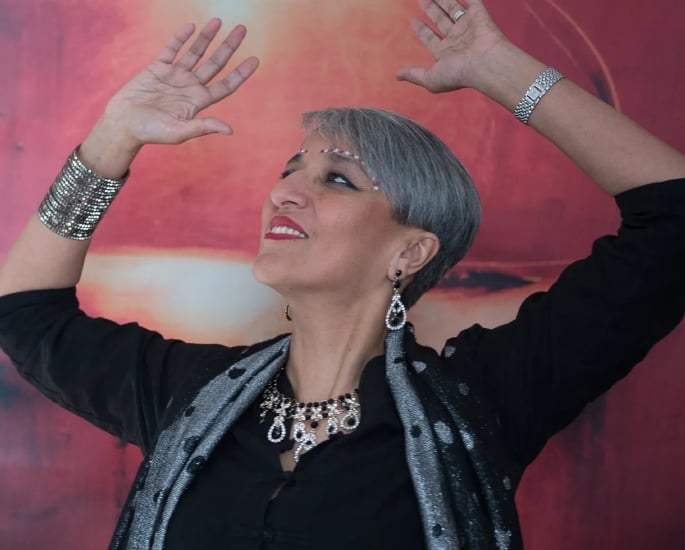

That is tricky – it’s like asking which is my favourite child!
I love them equally of course, but they each brought different challenges and rewards.
Some never made it onto this album. Hopefully, I will get them on the next album!
If I had to choose one it has to be ‘Borrowed Body’ – the lead single.
It was written in response to the imminent death of my long-time friend and musical collaborator, the glorious Sianed Jones.
It was written just as I knew Sianed was dying.
I was attempting to meditate in my studio, but her presence was so strong, she permeated everything.
I tried to focus on my breath, welcoming the healing tears, as usual.
But I couldn’t. I suddenly found that I had jumped up and the chorus of this song just came to me, complete. I
hit record and began to sing. I didn’t even have a chance to change any settings on my DAW, it was too nebulous and fleeting and I did not want to lose it.
(NERD alert: Which is why it’s a preset BPM of 120!)
But it worked. It was REAL. It was what I felt so deeply at that moment. I felt her spirit.
Grief does odd things.
I explained more about how precious and beautiful this song is for me on my blog here.
How do use fusion music to create a cohesive musical experience?
I write quite simply, in both Urdu and English.
I can’t really write like the great masters as my Urdu is not at all sophisticated – maybe because I came to the UK at the age of 6.
“I didn’t begin my musical training until I was in my 20s.”
Then, I went to art college in my 40s, so nothing is very complicated.
I think that helps people to access it – the forms are simple, but the message has depth, I hope!
What’s the reaction to the album and your live visuals?
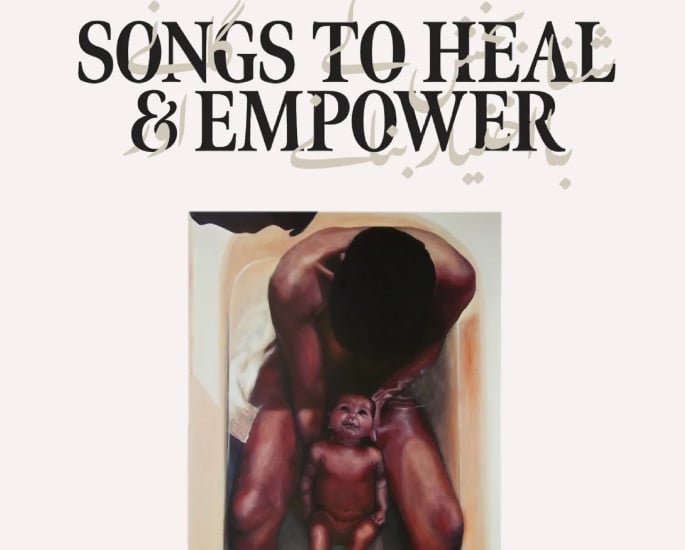

SO POSITIVE!
The live shows have had some amazing feedback.
Most importantly, reviewers are understanding what I was trying to achieve – which is to make it clear that art is POWERFUL stuff.
It can be used to inform and transform.
Visual art may be a more widely universally understood language than music.
Discuss! Seriously, I think it enhances because it comes from the same source, I explore exactly the same issues but in a different medium.
What role does collaboration play in bringing your music to life?
This latest album Songs To Heal and Empower is the one that has most of me, where I have written, composed, created, mixed, arranged, and produced the songs all by myself.
In the past, I have been blessed to have collaborated with acclaimed world-class artists.
These include celebrated Indian danseuse and activist Mallika Sarabhai, ‘sitarist to the stars’ Baluji Shrivastav OBE, Giuliano Modarelli, Al MacSween…and others.
“On the new album, I have the tabla of Sukhdeep Dhanjal.”
I also have the guitar by Giuliano Modarelli, Lois Lelland, and others.
I asked them, quite cheekily, if they would record some tracks for me to mix into my new work. And they said yes! How generous is that?
I was blown away by it and am so deeply grateful for this trust and affirmation that I will do justice to the work of these amazing musicians.
How do you see music as a tool for empowerment?
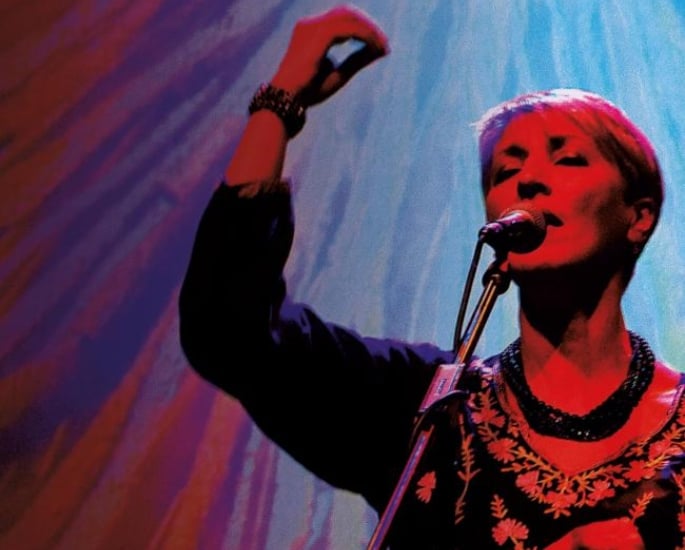

Wow. Music has saved my life over and over again. It has saved me – that is worth repeating.
It has shown me who I am, why I am Samia Malik, and what I can be. It is an extraordinary journey and such a privilege.
I have countless people who react to my work and understand the fact that this is all from my HEART – that’s why it touches the hearts and souls of others.
It connects. It heals. It empowers. It is POWERFUL.
Your music aims to bring communities together. How do you achieve this?
As I said, my music and my words attempt to connect us at our deepest level as humans.
I am like a bridge – a bit Asian, a bit western and I fit into places where other people may struggle.
I grew up in inner-city Bradford and have lived my adult life in Norfolk which, though less so now, is still predominately monocultural.
“My work in both communities is equally valid.”
I go into Asian women’s centres, and I go into rural village halls in Attleborough.
My message is accessible and the same: we can all live more deeply and more deeply connected.
Can you tell us more about your work with women refuges?
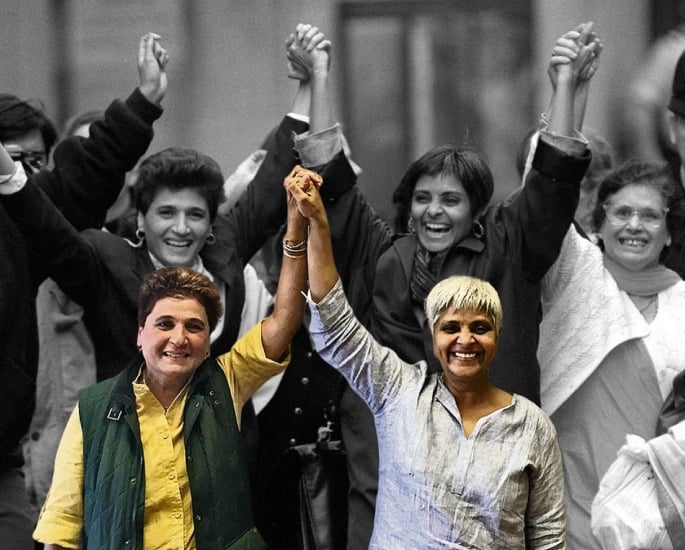

I came across Southall Black Sisters (SBS) in the early 80s.
It formed too late to personally support me when I was a young homeless mother in London, estranged from my family and culture, running from domestic abuse.
Their work and other specialist domestic violence charities across the country (indeed the world) do phenomenal important work to support women who are in desperate situations, as I was.
It is such a shame that this work is increasing, that these issues have never gone away.
I go directly into refuges if I can and start by sharing some of my songs in Urdu and English, translating if necessary.
I explain why I wrote and also HOW I write.
My earlier songs are based on my own experiences of coming from a Pakistani, Muslim background, growing up as an immigrant in the UK, and my journey to freedom.
I try to give participants the skills and tools to begin writing their own words, in their own languages, in a safe and supported atmosphere.
We end by perhaps sharing some of the work produced, though nobody has to share anything.
Often there will be a lively discussion about the issues and a talk about the future.
I am always amazed, awed, and humbled by these sessions – these women are so powerful!
My workshops just help them tap into it – to see you CAN survive, thrive, and tell your story. Our stories need to be told more widely.
What has been the most rewarding moment of your career so far?
It was when I went first into Southall Black Sisters to work with their support group for women – the reaction was extraordinary.
I sang, I talked, we laughed, we cried, I sang, I talked, we talked, we laughed, we cried some more, they wrote, we cried, we laughed, and so on.
When I came out (it was a hot day) I went and lay under a tree in a park and I thought ‘This is why I survived. This is what I must do.’
“But as I said at the start, I am now exploring even wider – the HUMAN condition.”
I am SO excited that Songs To Heal and Empower is out in the world and I get to share it across the country to such diverse audiences.
Samia Malik has truly provided us with a refreshing insight into her musical journey and the process behind her new album.
Her words can resonate with many audiences and the importance she places on music and artistry is unparalleled.
As she embarks on her national tour, Samia’s impact will reach new heights.
Through her performances and digital presence, she invites listeners to join her on a transformative journey, one that challenges perceptions, celebrates diversity and inspires positive change.
With her unwavering commitment to authenticity and inclusivity, and empowerment, Samia Malik stands as a shining example of the transformative power of art.
Listen to Songs to Heal and Empower and more of Samia Malik’s music here.